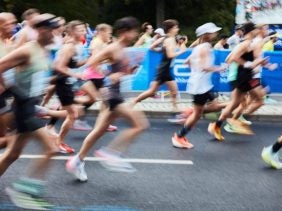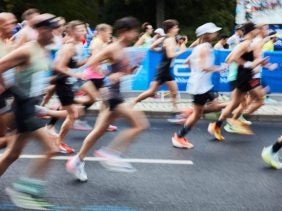Why alternative training makes you a better runner
 © Prostock-studio
© Prostock-studio
Training more often means that you can run better, faster and longer, doesn’t it? But that isn’t true. Many runners who post top times are triathletes who run significantly less, yet better and faster than many amateur athletes. Their secret is that they integrate variety into their training. Alternative training , such as cycling, swimming or completely different forms of training or exercise, are non-negotiable elements of their training plan.
But one thing is true: running is the only way to train to run. Alternative training supplements running training. The only time it can be a full replacement is when you’re injured. Because in order to train your entire musculoskeletal system to endure the repetitive nature of running, to get your running-specific muscles into top form and also to be mentally ready to deliver your top running performance, you have to lace up your running shoes regularly .
Related: Jogging at a glance: what you should know.
What is alternative training for runners?
Alternative training for runners is exercise that also trains endurance and speed. However, it focuses on things other than running and stresses your muscles differently, so it maintains or boosts the success of your endurance training.
You should always switch to alternative training if you’re scheduled to run, but can’t or don’t want to. If you’ve tweaked your knee, are tired or just don’t feel like running, then it’s time for alternative training. If you’re preparing for a half or full marathon, for example, or are just starting to run, alternative training should always be part of a good training plan for jogging.
Be careful that you don’t get confused: Alternative and complementary training are not the same thing. Complementary training is about specifically working the muscles that are neglected during running.
Alternative training for runners, on the other hand, can have various objectives . If you want to avoid repetitive stress to protect your joints, are injured but still want to work on endurance and speed, or want to improve your all-round fitness outside of the competition season, then you need alternative training.
You don’t train less, but differently – and better.
Say goodbye to the idea that alternative training means skipping a session, because the opposite is true. Alternative training allows you to give your all during your runs and still fit in an extra session. Or to drop a running session and push yourself to your limits in alternative training – it all depends on what suits your situation.
Why should runners choose alternative training? 5 reasons that will convince you
Alternative training is gentle and hard at the same time. While it offers variety and a break for running-specific muscles, it also challenges other muscles and your cardiovascular system. This trade-off is the key to why alternative training makes you a better runner.
#1 Alternative training is the best form of injury prevention
Running, running and nothing but running also means consistently the same stress for your musculoskeletal system. Increasing fatigue over the course of each training session and the training schedule itself means not only increased stress on your passive musculoskeletal system, but also on the muscles themselves. Stressing the same parts over and over again increases the risk of muscular imbalance, overload, and thus injury.
Alternative training adds variety, makes your muscles fitter all around and improves coordination – so it will ideally support itself and your passive musculoskeletal system, even during high-intensity or high-volume training sessions. This means that the risk of injury will be reduced.
Tip: The right running shoes will also reduce the risk of injury.
#2 Your running style will improve
Different types of alternative training focus on different parts of your musculature. This improves intramuscular coordination and allows movement sequences to become more economical and cleaner. The individual muscle fibers of the trained muscles communicate better with each other, and allow you to run better and with less effort. You should regularly incorporate the running ABCs into your runs.
#3 You’ll get stronger and have more endurance
Training other muscle parts will make your muscles stronger overall. More strength combined with improved coordination makes your muscles work more efficiently. In other words, you’ll have more power but consume less of it. And you’ll maintain your speed for longer.
#4 You’ll be able to train more intensively And you’ll make faster progress.
If your training plan includes 2 or 3 challenging units, then alternative training will let you add another one. Since this will be less challenging for your running-specific muscles, you can not only make the alternative training itself more intensive but also have more power left over for your running training itself.
Of course, the same still applies: if you are too tired or exhausted, take a break or only do a very gentle alternative workout. You should ideally plan an intensive training plan together with a trainer, so that you can adjust volumes, intensities and alternative training to your goals and your initial level of fitness.
#5 Your motivation will stay in the fast lane
Less monotonous repetitiveness = more motivation. Even if you always want to run, alternative training will ensure that you don’t lose that feeling.
These tips will also keep you on pace: 7 tips that increase your motivation to run.
When does alternative training make sense for runners?
Always! Occasionally varying the running-specific stress always makes sense. But it is even more valuable as a fixed part of your training plan if…
- you are injured.
- you want to slowly increase your training volume and intensity after an injury.
- you are prone to injury at high training volumes or intensities, but still want or need to train more frequently.
- you suffer from problems in your lower back or in the joints below your hips.
- you want to give your musculoskeletal system a break outside of competition season.
- you need a mental break from running.
- you are an overweight jogging novice.
Which sports are good alternative training options for runners?
Anything you enjoy. You’ll only want to incorporate things that you like doing into your training for the long term. The following sports are perfect alternative training options for runners: They will protect your joints, use your muscles in different ways than running, work your cardiovascular system and keep you fully fit.
Apart from that, there is plenty of variety, so there is sure to be something for you too.
These sports are perfect alternative training options for runners
- Cycling & spinning
- Rowing
- Swimming & aqua jogging
- Hiking & walking
- Cross-country skiing & inline skating
- Fast martial arts
- Strength training in your maximum strength range – especially for sprinters and anyone who wants to improve their speed
- Strength training using your own body weight – ideally in the form of circuit training alternating with light cardio exercises
- Step machine & cross trainer
- Step aerobics & dance workouts
Choosing which alternative training is suitable for you is an individual decision, especially when it comes to injuries. If you have problems with your thighs and calves, then swimming definitely makes more sense than cycling or step aerobics.
So consider the following questions when planning your alternative training to running:
- Why do I want to do alternative training?
- Are there certain weak points in my musculoskeletal system that I should take special care of or train?
What other sports should you do besides jogging?
If you run regularly, then compensatory training is essential for preventing muscular imbalances and one-sided overloads. Strength training for runners as well as stretching and mobility for runners are indispensable parts of your training plan. Yoga for runners is a good form of exercise that combines strength, mobility, flexibility and your mindset.
You might also be interested in this
- The Unexpected Mental Benefits of Running
- Is it possible to Jog and Build Muscle simultaneously?
- Basic endurance – how do you keep the pace for longer?
- 9 Surprising Tips For a Fast Recovery After Your Run
Sources for this article
We at foodspring use only high-quality sources, including peer-reviewed studies, to support the facts within our articles. Read our editorial policy to learn more about how we fact-check and keep our content accurate, reliable, and trustworthy.
































